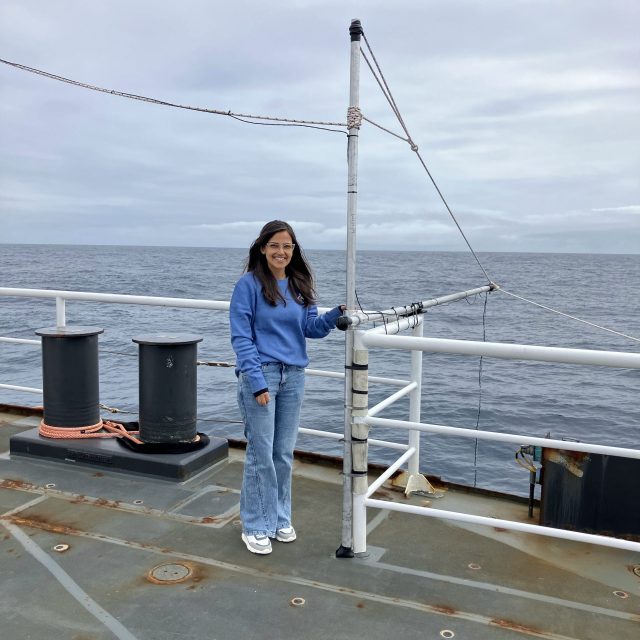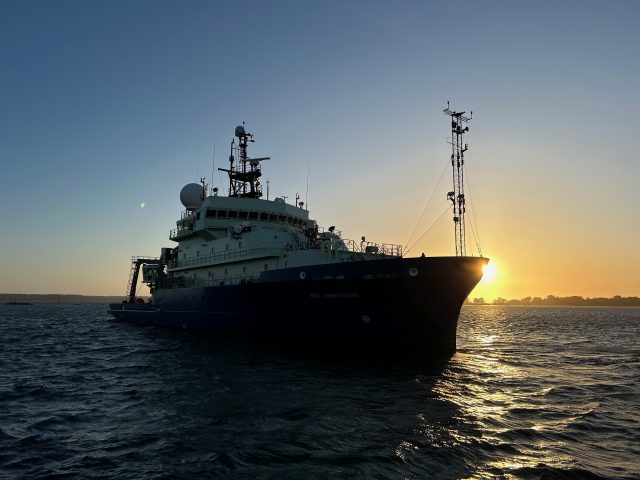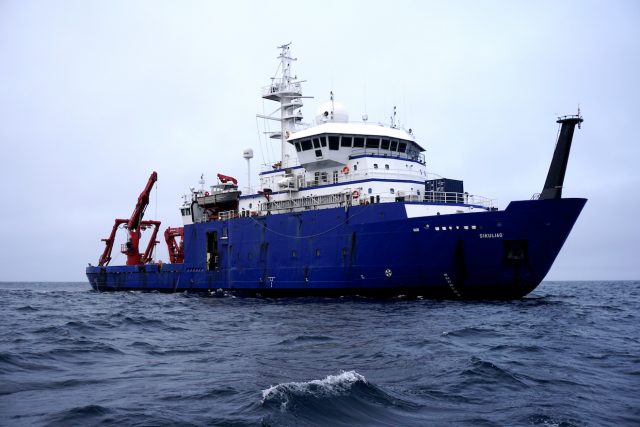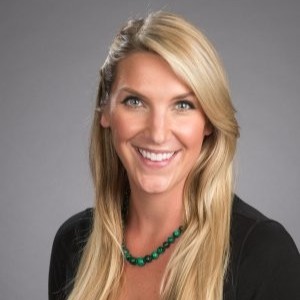News
Inside the Role of a Subsurface Mooring Lead
In the demanding field of oceanic exploration, a dedicated team of professionals from the Ocean Observatories Initiative (OOI) conducted the 11th annual cruise to the Station Papa Array in the Gulf of Alaska aboard the R/V Sikuliaq. Central to this mission was James Kuo, a Subsurface Mooring Lead (SML) at the Woods Hole Oceanographic Institution (WHOI), whose responsibilities were crucial to the voyage’s success.
Key Responsibilities
As the SML, James Kuo manages two flanking moorings and one hybrid profiler mooring. His primary responsibility is to ensure all instruments are fully operational before, during, and after deployment. This involves conducting thorough checks at each stage to confirm the equipment is in optimal condition for the year-long deployment. Occasionally, he must also address any issues that arise during deployment before leaving the array site, ensuring everything is functioning as intended.
During deployment, James primarily monitors engineering metrics, such as power consumption, to evaluate the health of the moorings. He also reviews scientific data—including pressure, temperature, and current velocities—to assess the moorings’ status and ensure that the instruments are positioned at the correct depths. This thorough approach provides a complete understanding of both instrument performance and the environmental conditions affecting the moorings.
When James and his team retrieve previously deployed moorings, they carefully inspect the instruments and analyze the data to identify any failures and determine their causes. Significant findings are annotated in the data stream to help scientists understand any anomalies during processing. Depending on the nature of a failure, these insights may lead to procedural changes or design modifications to improve future deployments.
Veteran of the Seas
James is well-versed in life at sea, having participated in approximately 28 cruises throughout his career. James is well-known for his ever-present smile while working to overcome daily challenges aboard the ship. Over his nine years at WHOI, he’s had the opportunity to explore diverse and exotic locations, including the Arctic, Norway, Italy, Chile, Uruguay, Iceland, Alaska, and various other domestic ports. Each expedition offers him a unique travel experience, venturing to places that are often beyond the reach of most travelers.
Career Development
James’s career in oceanography began in college as an intern at Scripps Institution of Oceanography where he assisted with various tasks and mooring assemblies. After graduating from University of California, San Diego (UCSD) with a degree in Structural Engineering, he joined Scripps full-time, focusing on mechanical design of moorings using CAD software.
During the first OOI Southern Ocean cruise in 2015, James collaborated with the WHOI team responsible for deploying the OOI Surface Mooring. A year later, WHOI recognized James’s expertise and offered him a position to continue his work with OOI. He focused on Subsurface Moorings, where he eventually became an expert in the field, mastering the intricacies of Subsurface Mooring platforms.
Future Aspirations
As the SML on the Papa expedition, James tackles a wide range of tasks and responsibilities, offering both significant challenges and rewarding opportunities. His journey from intern to Research Engineer reflects the dedication and expertise that have allowed him to excel in oceanographic research.
Looking forward, James sees significant growth opportunities at WHOI. He recently secured funding for a proposal to develop a mixed reality system for underwater ROVs, a project that is already underway. “The diverse projects and innovative opportunities offer the potential for a fulfilling and dynamic career,” said James.
[caption id="attachment_34599" align="alignnone" width="640"]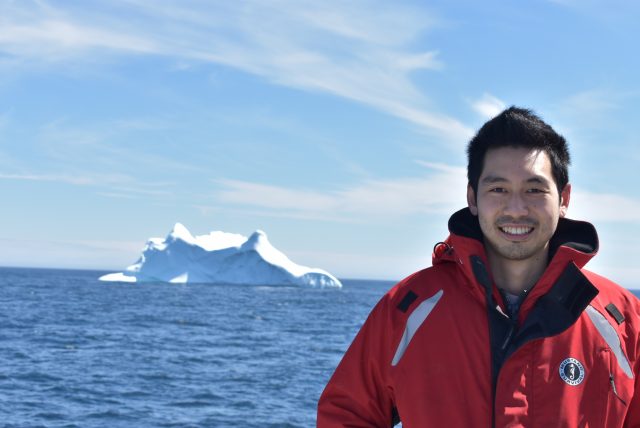 James Kuo, Research Engineer[/caption]
Read More
James Kuo, Research Engineer[/caption]
Read More Deep-Ocean Vertical Structure
It is often assumed that, at frequencies below inertial, the vertical structure of horizontal velocity and vertical displacement can be reasonably described by a single dynamical mode, e.g. the lowest order flat-bottom baroclinic mode. This is appealing because it would mean that first-order predictions of deep-ocean velocity structure could be determined from knowledge of density and surface currents. However, there is a relative paucity of full ocean depth data to test this idea. A study by Toole et al. (2023) used full ocean depth data from five sites – four of which are Ocean Observatories Initiative (OOI) arrays (Station Papa, Irminger Sea, Argentine Basin and Southern Ocean) – to address the question “does subinertial ocean variability have a dominant vertical structure?”
Data analysis was challenging, because it involved working with gappy records as well as combining information from multiple instruments on different moorings. As noted by the authors, “no single OOI mooring sampled velocity, temperature and salinity over full depth.” Wire-following profiler data from Hybrid Profiler Moorings were combined with ADCP and fixed-depth CTD data from adjacent moorings. While the authors note that “depth-time contour plots of the velocity data from each OOI site clearly reveal the shortcomings of the datasets” they also recognized that despite the shortcomings, “these observations constitute some of the only full-depth observations of horizontal velocity and vertical displacement from the open ocean.”
It was possible to obtain 2-3 years (non-contiguous in some cases) of near-full ocean depth data from each site. Inertial and tidal variability was removed, and the data were filtered over 100 hr (~4 days). Empirical Orthogonal Function (EOF) decomposition was used to identify an orthogonal basis set that described horizontal velocity and vertical displacement. In addition, dynamical modes were determined for three cases: flat bottom, sloping bottom and rough bottom. Note that computing the dynamical modes requires the vertical density profile, which was taken as the mean over each deployment. Analysis was focused on the lowest modes, which accounted for the majority of the variance.
The results (Figure 32) showed that there is an EOF consistent with a dynamical mode at most sites. However, the appropriate dynamical mode is different for each site – no single dynamical accounted for a dominant fraction of variability across all sites. The authors note that differences in bathymetry, stratification and local forcing complicate the picture, with different dynamical processes dominating at different sites. Prior studies (not full ocean depth) that appear to show a “universal” vertical structure may be misleading
This project shows the potential for OOI data, with appropriate processing and analysis, to provide unique insights into ocean structure and dynamics. The researchers have made the combined vertical profile data available to the community on the Woods Hole Open Access Server. The dataset DOI (https://doi.org/10.26025/1912/66426) is also linked here: https://oceanobservatories.org/community-data-tools/community-datasets/.
[caption id="attachment_34586" align="alignnone" width="624"] Mode 1 EOFs for velocity (u, red; v blue; cm/s) and vertical displacement (black, decameters) for OOI arrays at (from left) Argentine Basin, Southern Ocean, Station Papa and Irminger Sea. Adapted from Toole et al., 2023.[/caption]
Mode 1 EOFs for velocity (u, red; v blue; cm/s) and vertical displacement (black, decameters) for OOI arrays at (from left) Argentine Basin, Southern Ocean, Station Papa and Irminger Sea. Adapted from Toole et al., 2023.[/caption]
___________________
References:
Toole, J.M, R.C. Musgrave, E.C. Fine, J.M. Steinberg and R.A. Krishfield, 2023. On the Vertical Structure of Deep-Ocean Subinertial Variability, J. Phys. Oceanogr., 53(12), 2913-2932. DOI: 10.1175/JPO-D-23-0011.1.
Read MoreSubsurface Acoustic Ducts in the Northern California Current System
Xu et al.’s analysis of the hydrographic data recorded along the U.S. Pacific Northwest coastline leads to the identification of a secondary subsurface acoustic duct. A numerical simulation based on the sound-speed field determined from OOI Coastal Endurance and APL-UW glider CTD data suggests that the presence of the duct has major impact on sound propagation at a mid-range frequency of 3.5 kHz in the upper ocean (Figure 31). Specifically, the ducting effect is evident in the trapping of sound energy and the consequent reduction in transmission loss within the duct. Glider observations show that the duct is a large-scale phenomenon that extends hundreds of kilometers from the outer continental shelf to regions offshore of the continental slope. The axis of the duct shoals onshore from between 80 and 100 m depth offshore of the continental slope to less than 60 m over the shelf. Analysis of the sound-speed profiles determined from glider CTD data suggests that the prevalence of the duct decreases onshore, from over 40% in regions offshore of the continental slope to less than 5% over the shelf. In addition, analysis of the long-term time series of sound-speed profiles determined from the CTD data recorded over the shelf slope off the Washington Coast suggests that the duct is more prevalent in summer to fall than in winter to spring. Furthermore, examination of concurrent OOI Coastal Endurance Array (Washington Offshore Profiling Mooring) observations of sound speed and flow velocity indicates that the duct observed over the shelf slope is associated with a vertically sheared along-slope velocity profile, characterized by equatorward near-surface flow overlaying poleward subsurface flow.
[caption id="attachment_34581" align="alignnone" width="462"] (adapted from Fig. 3 of Xu et al., 2024) (a) The sound-speed field obtained from the CTD data recorded by an OOI-CEA coastal glider during 06-16 October 2018. The contour lines are potential density (in kg/m3). The magenta dots mark the locations of the local sound-speed minima along the axis of the subsurface duct. (b) The trajectory of the Seaglider. The red dot marks the location of the OOI-CEA Washington Offshore profiler mooring. The bathymetry contour lines mark seafloor depths in 100 m increments between 10 and 500 m and then in 500 m increments between 500 and 3000 m. (c) The vertical sound-speed profile at 20 km along-track distance. The local sound-speed minimum at the axis of the duct is labeled.[/caption]
(adapted from Fig. 3 of Xu et al., 2024) (a) The sound-speed field obtained from the CTD data recorded by an OOI-CEA coastal glider during 06-16 October 2018. The contour lines are potential density (in kg/m3). The magenta dots mark the locations of the local sound-speed minima along the axis of the subsurface duct. (b) The trajectory of the Seaglider. The red dot marks the location of the OOI-CEA Washington Offshore profiler mooring. The bathymetry contour lines mark seafloor depths in 100 m increments between 10 and 500 m and then in 500 m increments between 500 and 3000 m. (c) The vertical sound-speed profile at 20 km along-track distance. The local sound-speed minimum at the axis of the duct is labeled.[/caption]
___________________
References:
Guangyu Xu, Ramsey R. Harcourt, Dajun Tang, Brian T. Hefner, Eric I. Thorsos, John B. Mickett; Subsurface acoustic ducts in the Northern California current system. J. Acoust. Soc. Am. 1 March 2024; 155 (3): 1881–1894. https://doi.org/10.1121/10.0024146
Read MoreAxial Seamount: The Phoenix Rises
Regional Cabled Array live data feeds from the bottom pressure tilt, seismic, and temperature-resistivity instruments are capturing a marked increase activity at Axial Seamount with total seafloor uplift approaching the threshold depth for the 2015 eruption. As noted by W. Chadwick (OSU), whose website provides daily forecasts, the average differential inflation rate has almost doubled in the last six months. Bottom pressure tilt data at the Central and Eastern Caldera sites, show a marked increase in uplift beginning in April increasing from ~ 6 cm/yr to ~10 cm/year. The increase in uplift rates is coincident with a dramatic increase in seismic activity [viewable on daily plots of earthquakes accessible on W. Wilcock’s Axial Earthquake Catalogue (UW)] with >1000 earthquakes in a 24 hr period also occurring in April: seismic activity remains, high, but has not reached the 1000’s per day as detected prior to the April 2015 eruption (Wilcock et al, 2016). The hydrothermal system in the International District Hydrothermal Field, located on the eastern rift zone within Axial Caldera, is also responding to this increased activity. Fluid temperatures measured by the temperature-resistivity sensor in a parasitic orifice on the side of the hydrothermal vent Escargot show an increase in the past 6 months, with a marked change in the past 3 months (Courtesy of W. Ruef, UW). Excitement is building as we watch this dynamic volcano respond to melt migration 2 km below the seafloor – January 2025 is not far away.
[caption id="attachment_34576" align="alignnone" width="597"]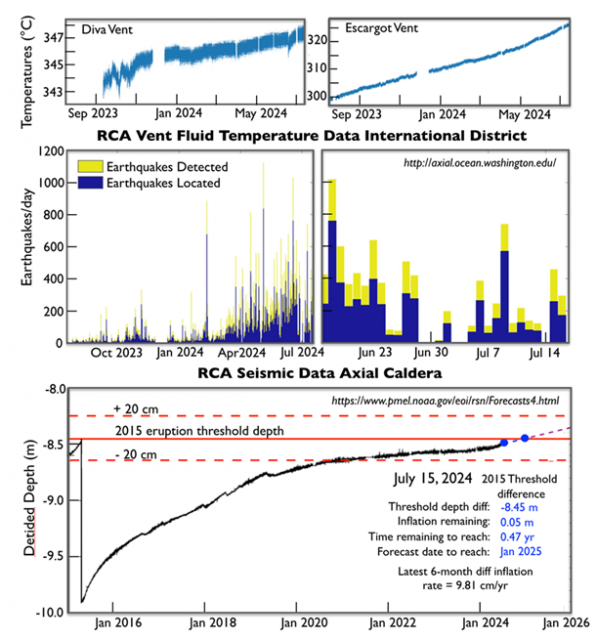 RCA bottom pressure tilt data Central Caldera Axial Seamount[/caption]
Read More
RCA bottom pressure tilt data Central Caldera Axial Seamount[/caption]
Read More POGO Fellow Aditi Sharma Returns from Sea and Reflects on 17-Day Expedition
Partnership for Observation of the Global Ocean (POGO) Fellow Aditi Sharma has returned from a 17-day expedition aboard the R/V Sikuliaq to recover and deploy OOI’s Global Station Papa in the Gulf of Alaska. A PhD candidate at the National Institute of Oceanography India, Aditi was chosen from over 80 applicants for a shipboard training fellowship sponsored by POGO, WHOI, OOI, and the Nippon Foundation.
Back on land, Aditi is reflecting on her time at sea and her goals for the future.
How did you benefit from the training?
The training has been immensely beneficial as it provided me with a chance to engage in work and learn from the experts in the field. The hands-on operations of winch, deployment procedures, data downloading, and calibration techniques have given me confidence in practical skills essential for the fieldwork. These experiences are particularly relevant as I now intend to apply them to my current project at my parent institute, which involves monitoring diverse environmental variables in the coastal Bay of Bengal using advanced meteorological sensors on a fixed mooring buoy. This training has helped in enhancing my capability to contribute meaningful insights to the project. In addition to the scientific aspects, the training has provided me with an understanding of the operational challenges during expeditions. It has highlighted the need for improvisation in adverse weather conditions and emphasized collaborative work approaches. Additionally, it has instilled in me a strong sense of time management that I aim to apply both in my career and in my personal life.
What are your future aspirations?
I am currently working towards my PhD at the National Institute of Oceanography. Upon completing my PhD, I aim to pursue postdoctoral studies and collaborate with fellow scientists in my specialized field. This journey represents a vast ocean of knowledge that I am eager to explore, with a strong desire to effectively share and discuss my insights with peers.
[caption id="attachment_34524" align="alignnone" width="640"]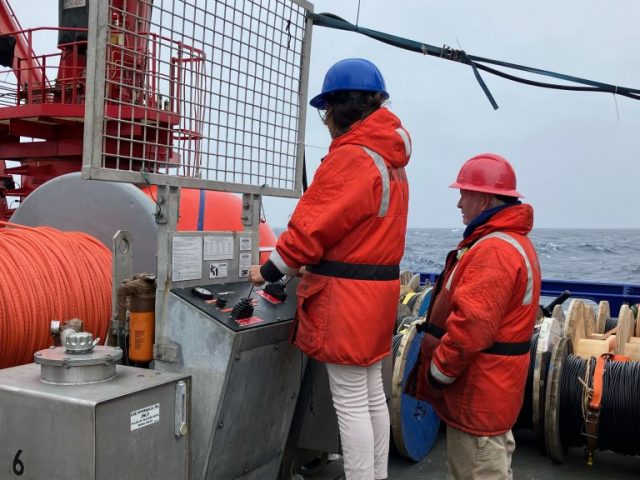 Aditi Sharma aboard R/V Sikuliaq[/caption]
Read More
Aditi Sharma aboard R/V Sikuliaq[/caption]
Read More Opportunity to Add New Sensors/Equipment to Pioneer MAB Array
The U.S National Science Foundation (NSF) Ocean Observatories Initiative (OOI) is excited to report that the relocation of the Pioneer Array to the Mid-Atlantic Bight (MAB) is now complete and the OOI facility is again considering requests by Principal Investigators to add new sensors and/or equipment to the Pioneer MAB Array. The process for requesting additions to the Array is described here.
The MAB deployment is the culmination of a three-year, multi-tiered process to relocate the Pioneer Array from its former location off the New England Shelf to the MAB. The NSF and the OOI Facilities Board (OOIFB) hosted a series of workshops in 2021 to elicit community input on where a relocated Pioneer Array might best meet science and educational needs. Based on input from these community workshops, the NSF gave its approval to the MAB site and the process was launched. Data from most instruments is available in real-time from the OOI Data Explorer. All non-telemetered data will be available after instruments are recovered on Array maintenance cruises that occur at nominal six-month intervals (April, October).
“Completing installation of the Pioneer Array in the MAB was the culmination of a significant effort by the OOI Team,” said Al Plueddemann, who served as the Chief Scientist for the first deployment of the array in the MAB and is Principal Investigator for OOI’s Coastal and Global Scale Nodes. “The time is right for researchers to propose additional sensors or equipment be added to the array so its full data collection potential can be realized.”
Notes:
- The installation of some sensors, especially acoustic sensors, may be subject to compliance with NSF’s Memorandum of Understanding with the US Navy.
- While the requests must be made for any additions to the Array, OOI would appreciate notification on plans to deploy stand-alone instrumentation within the OOI footprint.
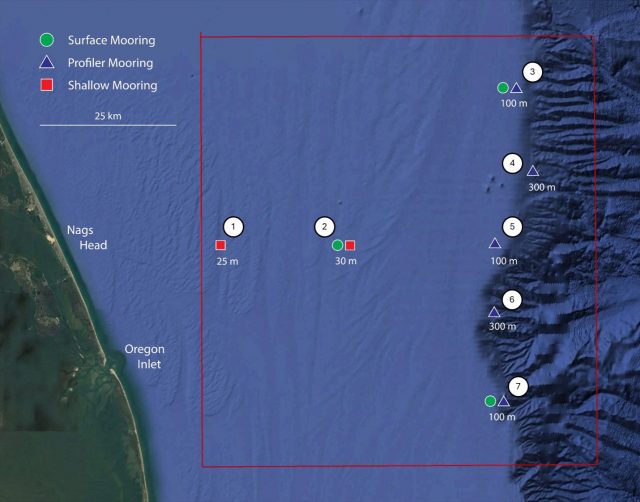 Pioneer MAB Layout[/caption]
Read More
Pioneer MAB Layout[/caption]
Read More Graduate Students Apply Now for Endurance Fall Shipboard Experience
Upcoming cruise volunteer opportunity on NSF Ocean Observatories Initiative Coastal Endurance Array Expedition
When: Leave Newport, Oregon on October 4, 2024; return to Newport on October 20, 2024
Applications Due: August 30, 2024
There is an opening for a student volunteer in the Fall 2024 as part of the U. S. National Science Foundation Ocean Observatories Initiative (OOI) Coastal Endurance Array on R/V Sikuliaq. The Coastal Endurance Array team will deploy and recover oceanographic moorings, profilers and gliders off Washington and Oregon. Seven surface moorings will be deployed and recovered along with up to four profilers and six gliders. The team will also conduct CTD (Conductivity, Temperature, and Depth) casts, with bottle sampling, and collect underway ship data for comparison to data from deployed equipment.
The selected volunteer will have the opportunity to assist in the deployment and recoveries of moorings and water sample processing. They will also have opportunities to work directly with OOI data. The cruise will consist of two legs, each lasting about 8 days. Interested applicants can apply to participate on either or both legs. Domestic (within the USA) travel reimbursement is possible.
The primary goal of this program is to provide graduate students currently completing (or who have recently completed) a degree in a field of oceanographic research with the opportunity to participate in a research cruise. The participant will be a member of the scientific party and be involved in data collection and all other activities at sea. It is envisioned that the individual will be familiar with the science to be conducted at sea, and thus, form new collaborations and potentially develop new research directions. To be eligible to participate, the individual must either currently be studying at a U.S.-based institution or be a recent graduate, and have either a U.S. Passport or an applicable U.S. Visa.
Questions and application materials should be sent to Edward.Dever@oregonstate.edu. Application materials are:
- a CV or resume
- a one page letter of interest describing how this opportunity fits their professional and/or research interests
- contact information for two references.
For a first-hand view of what to expect at sea, check out this video.
[media-caption path="https://oceanobservatories.org/wp-content/uploads/2024/06/Sikuliaq-1.jpeg" link="#"]R/V Sikuliaq, University of Alaska Fairbanks.[/media-caption] Read MoreGlobal Station Papa Expedition Succeeds Despite Weather
And what a wild ride it was! The US National Science Foundation Ocean Observatories Initiative (OOI) 11th expedition to the Global Station Papa Array aboard the R/V Sikuliaq had a bit of trouble with the weather gods during its 17-day journey in the Gulf of Alaska. For safety reasons because the ship cannot deploy large moorings in conditions with ~20’ seas and high winds, the ship spent almost five of the 17-days moving in and out of the array site, trying to find “safer ground” to wait out the worst of the storms.
Nonetheless, the Coastal and Global Scale Nodes team (CGSN) based at Woods Hole Oceanographic Institution (WHOI) and a Waverider mooring team from the University of Washington succeeded in meeting all their mission objectives. Despite the extra transit and down days, the teams recovered and deployed three OOI subsurface moorings and two open ocean gliders. They recovered and deployed a Waverider mooring for the University of Washington. A POGO Fellowship awardee was onboard and gained valuable shipboard experience, including experiencing how safety is the underlying foundation of these at-sea operations.
[media-caption path="https://oceanobservatories.org/wp-content/uploads/2024/06/Hybrid-1.jpg" link="#"]The CGSN team successfully deployed a Hybrid Profiler Mooring (HYPM) at the Station Papa Array. The HYPM is in a water depth of ~4000m and is equipped with two profiling vehicles that move up and down the riser wire at regular intervals to collect data for almost the full water column. An anchor (left) holds the mooring in place during its yearlong deployment. Credit: Dee Emrich © WHOI.[/media-caption] [media-caption path="https://oceanobservatories.org/wp-content/uploads/2024/06/hybrid2.jpg" link="#"] An anchor holds the Hybrid Profiler mooring in place during its yearlong deployment. Credit: Dee Emrich © WHOI.[/media-caption]The team also successfully conducted water sampling at the deployment sites and collection of shipboard underway data.
“It was a pleasure participating in the Papa 11 cruise with such a professional and able team,” said Chief Scientist Kristopher Newhall. “And as always, I can’t say enough about the skill and professionalism of the R/V Sikuliaq’s officers and crew.” This is the fifth time Newhall has led the annual recovery and deployment cruise to Global Station Papa.
[media-caption path="https://oceanobservatories.org/wp-content/uploads/2024/06/Biofouling-2.jpg" link="#"]In addition to deployments of OOI moorings and gliders, the CGSN team assisted colleagues at the University of Washington Applied Physics Laboratory deploy a waverider mooring at the Global Station Papa Array, providing wave data wave such as height, period, and direction from this important site. Credit: Dee Emrich © WHOI.[/media-caption]The site is in the Gulf of Alaska, about 620 nautical miles offshore, in a critical region of the northeast Pacific with a productive fishery subject to ocean acidification, low eddy variability, and impacted by the Pacific Decadal Oscillation. “We are pleased that Station Papa is now set to provide data for the next year from this critically located region,” Newhall added.
A more detailed report of the expedition can be found here.
[media-caption path="https://oceanobservatories.org/wp-content/uploads/2024/05/IMG_6769-scaled.jpeg" link="#"]Credit: Jim Edson © WHOI.[/media-caption]
Read More
Amber Stronk Appointed New OOI Community Engagement Manager
Principal Investigator of the U.S. National Science Foundation Ocean Observatories Initiative (OOI) Program Office James B. Edson today announced that Amber Stronk is the new OOI Community Engagement Manager. Stronk assumed her responsibilities on June 24, taking over for Darlene Trew Crist, who has served in this role since January 2020. Trew Crist announced her retirement in January 2024, which led to an exhaustive search to find a qualified replacement.
“Darlene’s done an exceptional job for OOI and leaves very big shoes to fill, but we are delighted to have Amber assume the reins of this well-run effort. Amber brings a wealth of experience running communication and engagement operations for environmentally focused organizations and has a deep understanding of both the scientific and communication strategies essential to OOI. We are enthusiastic about the new energy and insights she will bring to the position,” said Edson.
Stronk most recently served as the Communications & Engagement Manager for the Marketing Science Institute. Previously, she was the Communications Manager for Sailors for the Sea Powered by Oceana, the world’s leading advocacy organization dedicated to ocean conservation. Her extensive background also includes communications roles at PricewaterhouseCoopers and the Broad Institute of MIT & Harvard. Stronk holds a master’s degree in marine biodiversity and conservation from the Scripps Institution of Oceanography and a BA in communications from Marist College.
To ensure a smooth transition, Stronk and Trew Crist will overlap in the position for two weeks, until July 5 when Trew Crist formally leaves Woods Hole Oceanographic Institution, where OOI’s program office is based.
The Ocean Observatories Initiative is a long-term infrastructure project funded by the U.S. National Science Foundation to gather physical, chemical, and biological data from the ocean, atmosphere, and seafloor and to deliver that data on demand and in near real-time online. The program includes moored instrument arrays and autonomous underwater vehicles deployed at critical locations in the coastal and open ocean worldwide. Data from the observatories help researchers address questions across short and long time periods, small and large spatial scales, and from the ocean surface to the seafloor. OOI is managed by the Woods Hole Oceanographic Institution (WHOI) and implemented by WHOI, the University of Washington and Oregon State University.
Read More
Rosetta Stone for OOI Sensor Names
 OOI’s instrument page is the Rosetta Stone for deployed instruments.[/caption]
OOI’s instrument page is the Rosetta Stone for deployed instruments.[/caption]
Ever wonder what a SPKIR is? If the meaning isn’t top of mind, SPKIR is the Spectral Irradiance sensor (Sea Bird OCR-507 multispectral radiometer), which measures Spectral Irradiance. What about ADCP? This stands for Acoustic Doppler Current Profilers that use acoustics to measure 3D water-current velocity for a small volume of the water column above or below the sensor. The sensor calculates velocity by measuring changes in the sound waves.
All of this information and more is available on OOI’s website on the “Rosetta Stone for OOI Sensor Names” (instrument page) at https://oceanobservatories.org/instruments/. Bookmark this page where you can easily find the definition of these acronyms, as well as a visual of what the instrument looks like and information on how it works. In addition, you can be linked to data products specific instruments create, and much more.
Read More
